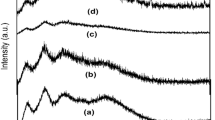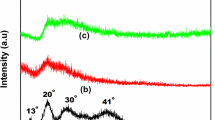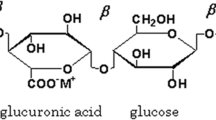Abstract
A proton-conducting polymer electrolyte based on agar and ammonium nitrate (NH4NO3) has been prepared through solution casting technique. The prepared polymer electrolytes were characterized by impedance spectroscopy, X-ray diffraction, and Fourier transform infra-red spectroscopy. Impedance analysis shows that sample with 60 wt.% NH4NO3 has the highest ionic conductivity of 6.57 × 10−4 S cm−1 at room temperature. As a function of temperature, the ionic conductivity exhibits an Arrhenius behaviour increasing from 6.57 × 10−4 S cm−1 at room temperature to 1.09 × 10−3 S cm−1 at 70 °C. Transport parameters of the samples were calculated using Wagner’s polarization method and thus shows that the increase in conductivity is due to the increase in the number of mobile ions. Fuel cell has been constructed with the highest proton conductivity polymer 40agar/60NH4NO3 and the open circuit voltage is found to be 558 mV.











Similar content being viewed by others
References
Smitha B, Sridhar S, Khan A (2005) Solid polymer electrolyte membranes for fuel cell applications—a review. J Membr Sci 259:10–26
Casciola M, Alberti G, Sganappa M, Narducci R (2006) On the decay of Nafion proton conductivity at high temperature and relative humidity. J Power Sources 162:141–145
Lu D, Xiao C, Xu S (2009) Starch-based completely biodegradable polymer materials. Express Polym Lett 3:366–375
Ponez L, Sentanin F, Majid S, Arof A, Pawlicka A (2012) Ion-conducting membranes based on gelatin and containing LiI/I2 for electrochromic devices. Mol Cryst Liq Cryst 554:239–251
Aziz SB, Abidin Z, Arof A (2010) Effect of silver nanoparticles on the DC conductivity in chitosan–silver triflate polymer electrolyte. Phys B Condens Matter 405:4429–4433
Nik Aziz N, Idris N, Isa M (2010) Solid polymer electrolytes based on methylcellulose: FT-IR and ionic conductivity studies. Int J Polym Anal Charact 15:319–327
Araki C (1966) Some recent studies on the polysaccharides of agarophytes. Proc Fifth Int Seaweed Symp 5:3
Raphael E, Avellaneda CO, Manzolli B, Pawlicka A (2010) agar-based films for application as polymer electrolytes. Electrochim Acta 55:1455–1459
Moon WG, Kim GP, Lee M, Song HD, Yi J (2015) A biodegradable gel polymer electrolyte for use in high-performance flexible supercapacitors. ACS Applied Materials Interfaces 7(6):3503–3511
Koh JCH, Ahmad ZA, Mohamad AA (2012) Bacto agar-based polymer electrolyte. Ionics 18:359–364
Singh R, Jadhav NA, Majumder S, Bhattacharya B, Singh PK (2013) Novel biopolymer gel electrolytes for dye-sensitized solar cell application. Carbohydr Polym 91(2):682–685
Singh R, Singh PK, Tomar SK, Bhattacharya B (2016) Synthesis, characterization and dye-sensitized solar cell fabrication using solid polymer electrolyte membranes. High performance polymers 28(1):47–54
Alias SS, Mohamad AA (2013) Effect of NH4I and I2 concentration on agar gel polymer electrolyte properties for a dye-sensitized solar cell. Ionics 19:1185–1194
Boukamp BA (1986a) A nonlinear least squares fit procedure for analysis of immittance data of electrochemical systems. Solid State Ionics 20:31–44
Boukamp BA (1986b) A package for impedance/admittance data analysis. Solid State Ionics 18:136–140
Aji MP, Bijaksana S, Abdullah M (2012) A general formula for ion concentration-dependent electrical conductivities in polymer electrolytes. Am J Appl Sci 9:946
Shukur M, Kadir M (2015) Electrical and transport properties of NH4Br-doped corn starch-based solid biopolymer electrolyte. Ionics 21:111–124
Khiar AA, Arof A (2010) Conductivity studies of starch-based polymer electrolytes. Ionics 16:123–129
Appetecchi G, Romagnoli P, Scrosati B (2001) Composite gel membranes: a new class of improved polymer electrolytes for lithium batteries. Electrochem Commun 3:281–284
Appetecchi GB, Croce F, Romagnoli P, Scrosati B, Heider U, Oesten R (1999) High-performance gel-type lithium electrolyte membranes. Electrochem Commun 1:83–86
Lan Z, Wu J, Lin J, Huang M, Li P, Li Q (2008) Influence of ionic additives NaI/I 2 on the properties of polymer gel electrolyte and performance of quasi-solid-state dye-sensitized solar cells. Electrochim Acta 53:2296–2301
Chirapart A, Ohno M, Ukeda H, Sawamura M, Kusunose H (1995) Chemical composition of agars from a newly reported Japanese agarophyte, Gracilariopsis lemaneiformis. J Appl Phycol 7(4):359–365
Armisen R, Galatas F (1987) Production, properties and uses of agar. Production and utilization of products from commercial seaweeds FAO Fish Tech Pap 288:1–57
Christiaen D, Bodard M (1983) Spectroscopie infrarouge de films d ‘agar de Gracilaria verrucosa (Huds.) Papenfuss. Bot Mar 26:425–428
Rochas C, Lahaye M, Yaphe W (1986) Sulfate content of carrageenan and agar determined by infrared spectroscopy. Bot Mar 29:335–340
El-Hefian EA, Nasef MM, Yahaya AH (2012) Preparation and characterization of chitosan/agar blended films: part 1. Chemical structure and morphology. Journal of Chemistry 9:1431–1439
Leones R, Sentanin F, Rodrigues L, Marrucho I, Esperança J, Pawlicka A, Silva M (2012) Investigation of polymer electrolytes based on agar and ionic liquids. Express Polym Lett 6:1007
Ramesh S, Liew C-W, Arof A (2011) Ion conducting corn starch biopolymer electrolytes doped with ionic liquid 1-butyl-3-methylimidazolium hexafluorophosphate. J Non-Cryst Solids 357:3654–3660
Ahmad N, Isa M (2016) Characterization of un-plasticized and propylene carbonate plasticized carboxymethyl cellulose doped ammonium chloride solid biopolymer electrolytes. Carbohydr Polym 137:426–432
Sikkanthar S, Karthikeyan S, Selvasekarapandian S, Pandi DV, Nithya S, Sanjeeviraja C (2015) Electrical conductivity characterization of polyacrylonitrile-ammonium bromide polymer electrolyte system. J Solid State Electrochem 19:987–999
Shamsudin I, Ahmad A, Hassan NH, Kaddami H (2016) Biopolymer electrolytes based on carboxymethyl К-carrageenan and imidazolium ionic liquid. Ionics:1–11
Rajeswari N, Selvasekarapandian S, Sanjeeviraja C, Kawamura J, Bahadur SA (2014) A study on polymer blend electrolyte based on PVA/PVP with proton salt. Polym Bull 71:1061–1080
Monisha S, Selvasekarapandian S, Mathavan T, Benial AMF, Manoharan S, Karthikeyan S (2016) Preparation and characterization of biopolymer electrolyte based on cellulose acetate for potential applications in energy storage devices. J Mater Sci Mater Electron 27(9):9314–9324
Ramya C, Selvasekarapandian S, Savitha T, Hirankumar G, Baskaran R, Bhuvaneswari M, Angelo P (2006) Conductivity and thermal behavior of proton conducting polymer electrolyte based on poly (N-vinyl pyrrolidone). Eur Polym J 42:2672–2677
Chai M, Isa M (2013) Electrical characterization and ionic transport properties of carboxyl methylcellulose-oleic acid solid polymer electrolytes. Int J Polym Anal Charact 18:280–286
Nithya H, Selvasekarapandian S, Kumar DA, Sakunthala A, Hema M, Christopherselvin P, Kawamura J, Baskaran R, Sanjeeviraja C (2011) Thermal and dielectric studies of polymer electrolyte based on P (ECH-EO). Mater Chem Phys 126:404–408
Kopitzke RW, Linkous CA, Anderson HR, Nelson GL (2000) Conductivity and water uptake of aromatic-based proton exchange membrane electrolytes. J Electrochem Soc 147:1677–1681
Kim C, Lee G, Liou K, Ryu KS, Kang S-G, Chang SH (1999) Polymer electrolytes prepared by polymerizing mixtures of polymerizable PEO-oligomers, copolymer of PVDC and poly (acrylonitrile), and lithium triflate. Solid State Ionics 123:251–257
Woo H, Majid S, Arof A (2012) Dielectric properties and morphology of polymer electrolyte based on poly (ɛ-caprolactone) and ammonium thiocyanate. Mater Chem Phys 134:755–761
Dutta P, Biswas S, De SK (2002) Dielectric relaxation in polyaniline–polyvinyl alcohol composites. Mater Res Bull 37:193–200
Sivadevi S, Selvasekarapandian S, Karthikeyan S, Sanjeeviraja C, Nithya H, Iwai Y, Kawamura J (2015) Proton-conducting polymer electrolyte based on PVA-PAN blend doped with ammonium thiocyanate. Ionics 21:1017–1029
Ramesh S, Yahaya A, Arof A (2002) Dielectric behaviour of PVC-based polymer electrolytes. Solid State Ionics 152:291–294
Wagner JB, Wagner C (1957) Electrical conductivity measurements on cuprous halides. J Chem Phys 26:1597–1601
Chandra S (1981) Superionic solids: principles and applications. North-Holland Publishing Co., Amsterdam. xi + 404, 22 × 15 cm, illustrated
Author information
Authors and Affiliations
Corresponding author
Rights and permissions
About this article
Cite this article
Boopathi, G., Pugalendhi, S., Selvasekarapandian, S... et al. Development of proton conducting biopolymer membrane based on agar–agar for fuel cell. Ionics 23, 2781–2790 (2017). https://doi.org/10.1007/s11581-016-1876-x
Received:
Revised:
Accepted:
Published:
Issue Date:
DOI: https://doi.org/10.1007/s11581-016-1876-x




